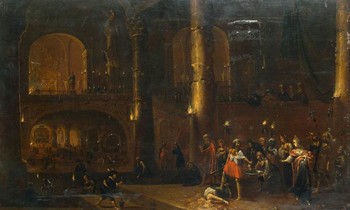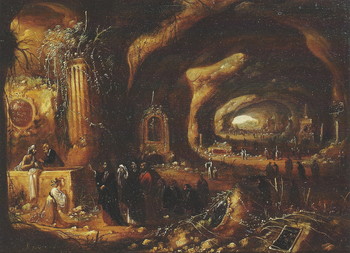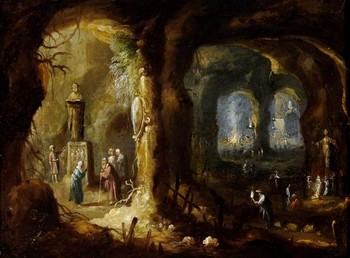3.500 €
The Angel accompanying Hagar and Ishmael
Oil on panel : 48,8 X 64,7 cm
Unsigned
Frame : 61,2 X 77,0 cm
In short
Rombout van Troyen was the Amsterdam specialist of highly atmospheric, narrative, almost operatic, Italianate cavern interiors. Although of simple origin van Troyen chose for a beautiful surname, van Troyen, meaning “from Troy”.
Ishmael, the ancestor of the Arabic people, (and his mother) was chased from his home by his own father Abraham. He favored his second son, Isaac, who became the ancestor of the Jewish people ... .
About Rombout van Troyen
Dutch painter
Amsterdam 1605 – in or after 1657 Amsterdam
(according to Piet Bakker and Anne Lenders, 2016, P. 11 – 38, Rombout van Troyen must have left Amsterdam for Leeuwarden circa 1655)
Painter of biblical and mythological subjects set in caverns. At the start of his career, until the early 1630s, he had painted Italianate landscapes and biblical subjects.
Pupil since the very young age of ten of the history painter Jan Pynas during seven years (between 1615/16 and 1622/23). Our Rombout was also influenced by Bartholomeus Breenbergh and through his Master by Jan’s brother, Jacob Pynas, and by Adam Elsheimer.
Arnold Houbraken in his biography of painters (“De Groote Schouburgh”, published in 1718) confirms that van Troyen loved Amsterdam and that he never travelled to Italy. He was born in a simple family: his father was a wheel turner, his grandfather a tailor. But for an unknown reason our painter chose for a beautiful new surname, van Troyen, meaning “from Troy”.
Van Troyen married twice: in 1632 (the couple had one daughter, his wife died already in September 1634) and in 1635 (seven children of which only one daughter reached an adult age).
About the subject of our painting
Abraham was the first Patriarch of the Old Testament and the founder of the Hebrew nation. He was married with Sarah, who had been unable to conceive a child. At the age of 75 Sarah offered her servant Hagar, who was an Egyptian slave, as a concubine to her husband. After Hagar became pregnant the tension rose between the two women. Hagar fled into the desert. At a spring an Angel appeared to her and instructed her to return to Abraham, this is not the subject of our painting. The son of Hagar and Abraham, named Ishmael, became the progenitor of the Arabic people.
Many years later, when Sarah was almost 90 years old, she finally fell pregnant of Abraham. Their son was named Isaac. The tension between both women rose again rapidly for many years. Sarah finally asked Abraham to send both Hagar and Ishmael away. Abraham followed the order of God to do so and sent them both into the Negev desert. This way Isaac became the sole heir of Abraham. God saved both Hagar and Ishmael: an Angel appeared to them, showing them a well of water. Just as his parents Ishmael lived to a very high age.
So the Angel of the Lord appeared twice to Hagar in the desert:
- once when she was alone and pregnant.
- Once when she and her young son had both been expulsed by Abraham. This is the subject of our painting.
Why should you buy this painting?
Because van Troyen treated the subject in a very original way, including at right a cavern interior and some Roman monuments.
Comparative paintings
Click photos for more details





